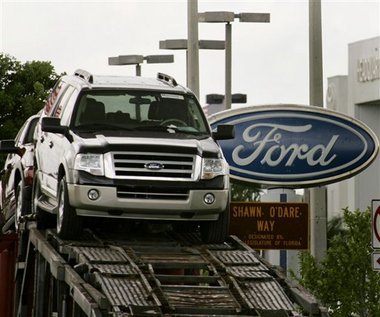Ford To Get Assets Back After Moody's Status Upgrade
 Ford Motor Co. is getting its blue oval logo back.
Ford Motor Co. is getting its blue oval logo back.
Moody’s Investors Service raised Ford’s debt ratings to investment-grade on May 22 for the first time in seven years. The upgrade means that all of Ford’s U.S. assets, including factories, the blue oval, and the trademarks for the F-150 pickup and Mustang sports car, are back in the company’s hands and will no longer be used to secure the company’s debt.
Ford never stopped using its logo or factories, but posted them as collateral in 2006 in order to get a $23.5 billion loan and avoid bankruptcy. Executive Chairman Bill Ford, the great grandson of company founder Henry Ford, said that giving up the rights to the oval was "enormously emotional for me personally and for my family."
"This is one of the best days that I can remember," Bill Ford said in a conference call with reporters.
Ford needed investment-grade ratings from two of the three ratings agencies to get its assets back from a group of banks that held them. Fitch Ratings upgraded the company in April. Standard and Poor’s has not yet upgraded Ford, and said in March that it didn’t expect to change Ford’s ratings within the next year.
Moody’s said it believes Ford can maintain its investment grade rating even in the face of a European downturn or other challenges. The company has approximately $20 billion in cash, and it has been disciplined about cutting costs, controlling production, and lowering spending on incentives, Moody’s said.
"The key factor in our considering an investment grade rating for Ford was whether or not the company would be able to sustain its strong performance," said Bruce Clark, Moody’s Senior Vice President. "We concluded that the improvements Ford has made are likely to be lasting."
Moody’s said one of Ford’s main strengths was its low break-even point in North America, the company’s largest market. The ratings agency calculated that Ford has to sell only 1.8 million cars and trucks before it starts turning a profit. In the twelve months that ended in March, Moody’s said, Ford shipped 2.7 million cars and trucks in North America, fifty percent more than that break-even point. Prior to its restructuring in 2009, Ford had to sell 3.4 million cars and trucks in North America to break even.
Moody’s also said Ford’s cars and trucks are increasingly competitive with Asian automakers, and it expects "robust" future products.
An investment-grade rating signals that a company’s debt has a low risk of default. Companies with investment grade credit ratings generally pay lower interest on debt. Ford also will have an easier time borrowing for projects like new plants in Asia. Moody’s said increasing sales in China is one of the biggest challenges Ford faces.
Moody’s also affirmed General Motors Co.’s credit rating of Ba1, one notch below investment grade, on Tuesday. Moody’s said GM remains on track to return to investment grade within the next year.
 Ford Motor Co. is getting its blue oval logo back.
Ford Motor Co. is getting its blue oval logo back.